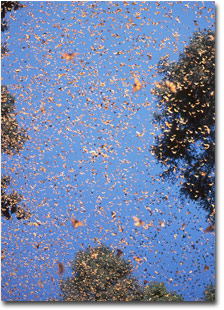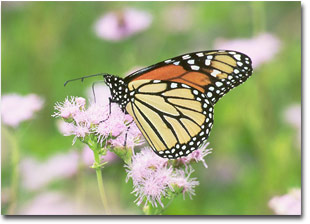Species Profile...
Monarch Butterflies Migrating
Text Copyright Gary Clark. Photography Copyright Kathy Adams Clark. All rights reserved.
 Monarch butterflies begin their annual migration south this month. These beautiful orange and black creatures depart Canada and the northern United States during the second week of August to head south, mostly through the central plains states. Along the way, they stop to feed on nectar-rich flowers and to lay eggs on milkweed plants.
Monarch butterflies begin their annual migration south this month. These beautiful orange and black creatures depart Canada and the northern United States during the second week of August to head south, mostly through the central plains states. Along the way, they stop to feed on nectar-rich flowers and to lay eggs on milkweed plants.
Few, if any monarchs, that leave the northern breeding grounds will make the 2,500-mile journey to their wintering grounds in central Mexico. Thatís because butterflies donít fly as powerfully or as swiftly as birds and their brief lifespan of three to six weeks hardly allows them time for the long journey unless, as happens in rare cases, they can fly 50 to100 miles a day.
Consequently, the progeny of adult monarchs that are born along the migratory route are the butterflies most likely to get to Mexico.
It all makes for an astounding plan of migration. The butterflies head south in August from a place like Thunder Bay, Ontario. They lay eggs along the migratory route and may make it to Kansas or even Texas before they die.
The eggs they lay produce a new generation of monarchs that continue to fly south along the ancestral route. The new generation of monarchs will also lay eggs, which ensures that even another generation will continue the migration to Mexico.
The majority of monarchs that make it to Texas by late August probably die a week or so after laying their eggs on milkweed. Caterpillars that hatch from the eggs feed on the milkweed leaves.
As the caterpillars mature, they form lovely green chrysalises that hang on silken threads called cremasters. Adult monarch butterflies emerge from the chrysalises about 10 days later, then mate and lay another batch of eggs. In October and November, all monarchs stop reproducing and make a mass exodus to Mexico.
Between 80 and 300-million monarch butterflies will migrate from Texas to a pine forest near the tiny mountain village of Angangueo in central Mexico. Most of these monarchs will move through central Texas and cross the border between Laredo and Del Rio. Other monarchs that follow the route from the New England states will move through Houston and cross the border between Brownsville and Laredo.
Luckily, a few monarch butterflies will spend the winter around my home in the Houston area.
However, millions of monarchs will ultimately gather at their winter home in the high mountains of the state of Michoachan, Mexico. They'll cling to the oyamel pine trees near Angangueo, 300 miles west of Mexico City.
 Monarchs will become dormant from December through January. In February, as the temperature rises and the sun warms the air, the monarchs will fly down to the ground to sip water out of the mountain streams. By late February, the migratory urge will propel them northward and they'll grace the skies of Texas in March.
Monarchs will become dormant from December through January. In February, as the temperature rises and the sun warms the air, the monarchs will fly down to the ground to sip water out of the mountain streams. By late February, the migratory urge will propel them northward and they'll grace the skies of Texas in March.
The best way to see monarch butterflies in autumn is to drive on back roads that cut through open fields where large concentrations of monarchs show up. Many will show up in city and county parks or even in your backyard.
Looking for autumn colors? Look for the monarch butterflies. Their rich orange wings streaked on top with elegant black lines and decorated underneath with splashes of silver make them as showy an autumn scene as you could ever ask for.
Gary Clark and Kathy Adams Clark - NPN 134
www.kathyadamsclark.com
Gary Clark's articles appear each week in the Wonders of Nature column in the Houston Chronicle. Kathy Adams Clark is a professional nature photographer who teaches photography courses and is a member of the Board of Directors of the North American Nature Photography Association. Visit their web site at www.kathyadamsclark.com.
Comments on NPN wildlife photography articles? Send them to the editor.


| 


